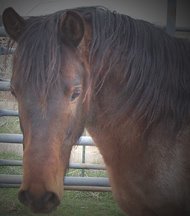Roaring, spewing farm truck? Shrug.
Tailings from a ground squirrel burrow? Danger, Will Robinson, DANGER! Hit the brakes! D-o-n'-t m-o-v-e...
Oh. Sorry. I was just replaying the soundtrack of my early trail rides on Consolation. Eleven days and five rides ago, I lamented that she suffered from speed deficit disorder on the trail. Young and green, out in the wide world away from her buddies, accompanied only by some human who hadn't a clue just how dangerous a pile of dirt can be, Consolation tended to move at a glacial pace.
This was unfortunate. As an endurance horse in the making, her default gait should be a working trot, and I had no intention of cajoling her along the thousands of miles we'll cover together in years to come.
I spent a few days pondering the issue, consulted some horsemen whose opinions I respect, then lined up the options and looked them over. They fell largely into two schools of thought:
- Give her time to adjust. Let her stop and smell the roses. Take slow rides with plenty of grazing stops, encouraging her to think of the trail as a pleasant place.
- Don't let her get away with it. Throw your heart down the trail and trot after it. Confidence breeds confidence.
I believe both options have merit. Because horses have unique personalities and needs, successful training depends on our ability to tailor lessons to the individual. So, I asked myself, what do I know about Consolation?
Consolation is royalty, that's what. She's as powerful as she is elegant, as smart as she is dominant. She's the kind of horse who can easily train a human, and she's more than willing to be a leader if her human is not. Furthermore, any human who's going to lead her will either be fair, firm, consistent, and trustworthy -- or dethroned.
It seemed to me that if I took Option 1, the smell the roses route, Consolation would quickly learn that being "looky" meant less work. If I allowed her to poke along, pausing to eyeball every aberration in her surroundings, she'd control the situation and we'd never get anywhere, either literally or figuratively.
That left Option 2, which I decided to apply along with a healthy dose of empathy. While I would require Consolation to trot most of the trail, I would simultaneously respect her trepidation. Here's how the plan looked in action:
After several minutes of walking to warm up, I asked Consolation for a medium trot along a familiar route. She responded. When I saw something ahead that I suspected would alarm her, I cued her to swerve away from it before she did so on her own.
This communicated a powerful message: I am looking out for you. I will keep you safe by helping you avoid danger. I will not force you into a situation you aren't ready to face. In return, I expect you to trust me enough to carry me where I ask, at the speed I request.
The result? After just a few rides, our pace has picked up (see Consolation's Conditioning Log in the sidebar), our relationship has strengthened, and we're both having more fun. No more pausing and nagging, hesitating and urging -- just a steady trot, often right past the same obstacles that only last week were cause for concern.
I love it when I choose well.A couple caveats:
First, I don't mean to imply that I never let Consolation stop to look at a particularly horrifying bogeyman. Sometimes, it's only fair and prudent to allow a horse extra time to evaluate a perceived danger. The spooks I'm asking Consolation to trot confidently past are of the everyday variety -- stumps, slabs of concrete, tumbleweeds, gated pipe -- things we've been by often enough that there's no real excuse for "looky" behavior. (You'll recall that Consoliation is in her second month of trail rides, and we walked a lot of miles in hand before starting her under saddle. The above plan would not be appropriate for a horse's first trail experience.)
Second, my plan will only work if the horse's "hustle" button is properly installed. Before taking Consolation back out on the trail, I spent a couple, short sessions in the round corral making sure she understood that a trot command means exactly that, and she is required to "hustle," that is, speed up within the gait, upon demand. Enforcing this lesson was a simple matter of giving the command (first with thought, then seat, then voice, then leg, and finally tapping her hindquarters with a dressage whip as a last resort.) Consolation is no dummy; she got the message loud and clear. When she consistently responded to my seat and/or voice, I felt she was ready to return to the trail, and I gladly left the dressage whip behind.
_____________________________________
Related Posts
Breaking Free: Training the Herdbound Horse
Where To, Ma'am: First Trail Ride on a Green Horse
Thinking it Through: Training Horses as Individuals
Connecting the Dots: Breakthroughs in Horse Training
_____________________________________
Want to read more posts like this one? We deliver!










1 comment:
Loved this post! It was good for *me* to read. Sometimes I'm a bit guilty of advertising a perceived danger before "Royal" can even see it and often doesn't care. Perhaps he trusts me too much. I need to work on that.
Post a Comment